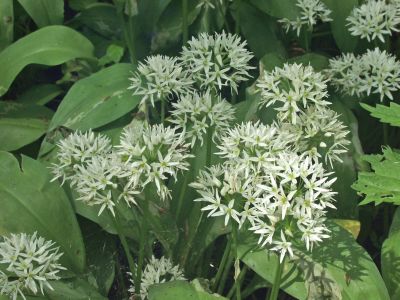Wild Garlic - Allium ursinum

Common Names: Wild Garlic, Ramsons, Bear's Garlic, Broad-leaved Garlic, Buckrams, Wood Garlic, Allium ursinum, European Wild Garlic, Bear Leek
Latin Name: Alium ursinum
Origin: Asia, Europe
Short Introduction
Wild Garlic grows naturally in the wild, especially across the Czech Republic. This herb can be found in lowland wooded areas and along watercourses. It thrives in moist environments, preferring sandy to clay soils with slightly acidic characteristics. In gardens or at home, a shady spot without invasive plants is ideal. Wild Garlic requires moist soil that does not need fertilization or extensive care. Grown in pots indoors, it is easy to cultivate and requires minimal maintenance.
Detailed Description
A herb renowned for its significant effects against high blood pressure and atherosclerosis.
Botanical Information
Wild Garlic is a perennial herb, typically growing to a height of 10–40 cm from a bulbous root. Its stem is upright, and the leaves are mostly basal and petiolate, with a smooth, bright surface due to a protective cuticle. The plant produces small, white flowers—up to 20 per cluster—forming an umbrella-shaped inflorescence. The fruit is a capsule.
Origin and Distribution
This perennial is native to the Old World. Originally found in the Caucasus and Eastern Europe, Wild Garlic has expanded across Europe and Asia. Despite being a common plant, it can be mistaken for Lily of the Valley in nature, which is toxic to humans. Foragers should take care to properly identify Wild Garlic, paying special attention to its shoots and leaves to distinguish it from lookalikes.
Usage / Dosage
Wild Garlic is traditionally used in both folk medicine and cuisine. Leaves and stems are gathered from late April to May, while the bulbs are typically harvested in August or September. Culinary use includes enhancing appetite and digestion. In folk remedies, Wild Garlic is employed for anemia, flu, high blood pressure, and asthma. The leaves can be added to salads, cooked briefly in soups, or used as a seasoning for pasta (a suitable alternative to basil).
For mild bacterial infections, Wild Garlic is prized for its antibacterial effects, similar to but less pungent than cultivated Garlic. It is also recognized for its anti-sclerotic actions—helping to prevent hardening of the arteries and associated cardiovascular complications by blocking processes leading to arterial blockage. These benefits are also attributed to its antioxidant activity, which helps prevent the creation of harmful radicals that could damage the immune system and blood vessel function. Wild Garlic contains substances that gently lower high blood pressure, reducing the risk of hypertension.
Its antibacterial potential supports cleansing of the kidneys and urogenital tract, thanks to a mild diuretic effect that flushes out pathogens and dead cells through increased urine flow. It is also known to clean and improve intestinal transit and heal ulcerative gastrointestinal diseases. Other positive effects of Wild Garlic include relief from bloating, diarrhea, colic, and intestinal cramps.
In cases of internal parasite infections such as roundworms and threadworms, Wild Garlic has proved effective for eradication. Its compounds also exhibit mild antifungal effects, especially against Candida albicans.
As a preventive measure, Wild Garlic is excellent for use in dietary supplements to protect against flu and colds. It has proven to clear the airways and relieve congestion, promote expectoration, and is thus best suited for wet, phlegm-producing coughs. Its ingredients also help lower blood sugar levels, making Wild Garlic a beneficial dietary supplement for most cardiovascular diseases.
The plant may be taken internally as solutions, infusions, tinctures, and in dry or fresh form—used in the kitchen as a herb or vegetable in salads or as a flavorful ingredient. It also has notable external uses: when applied to the skin, it takes advantage of its antibacterial and disinfectant properties.
Active Compounds
Like cultivated Garlic, whose most important active ingredient is essential oil, Wild Garlic is particularly rich in essential oils. Other key components include saponins, flavonoids, sulfur compounds, vitamins, and minerals. These compounds are similar in nature and quantity to those found in cultivated Garlic but are less aromatic, making Wild Garlic preferred for internal use by some.
Traditional Dosage
When consumed as over-the-counter capsules, tablets, or other medicinal preparations, a typical dosage is 1–3 times daily at a strength of 1000 mg Wild Garlic extract. For fresh, uncured plants, use less than one gram per person per day due to higher concentrations of active components, particularly essential oil and sulfur substances.
